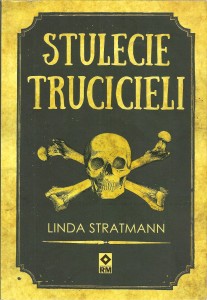„Stulecie trucicieli”, Linda Stratmann "The secret poisoner. A century of murder", Linda Stratmann
Jaka byłaby wasza pierwsza myśl, gdyby ktoś poprosił was o wymienienie substancji, których używali truciciele w obejrzanych lub przeczytanych przez was kryminałach? Większość z was pewnie musiałaby się trochę zastanowić. Jeśli czytaliście na przykład „Panią Bovary”, to zapewne przyszedłby wam do głowy arszenik, którego główna bohaterka użyła do popełnienia samobójstwa. Była to rzeczywiście najbardziej popularna substancja wykorzystywana przez ludzi, którzy chcieli kogoś otruć. Czy pomyśleliście o czymś jeszcze? Może tylko strychnina, wykorzystywana w trutce na szczury, i dlatego jeszcze w XIX stuleciu chętnie kupowana przez morderców (bo można było podać fałszywy cel zakupu). Hm… Tak, wiem, do niedawna również nie miałam wystarczającej wiedzy, aby wymienić cokolwiek innego. Ale kilka miesięcy temu dostałam książkę Lindy Stratmann „Stulecie trucicieli”, dzięki której mogłam dowiedzieć się nieco więcej na ten temat…
Na liście trucizn spisanej przez Stratmann oprócz arszeniku i strychniny znajduje się również laudanum – czyli nalewka z opium – oraz opium w czystej postaci, morfina, kwas pruski i wyciąg z liści tytoniu. Autorka opisuje przypadki zabójstw z użyciem tych substancji w XIX wieku, śledztwa prowadzone aby wykryć przyczyny śmierci, oraz rozwój technologii wykorzystywanej do wykrywania toksyn w ciałach denatów. Korzysta przy tym z szerokiej listy tekstów pochodzących z dokumentacji przechowywanej w British Library i The National Archives w Kev, jak również publikacji i periodyków medycznych oraz sądowych, ustaw parlamentarnych, oraz kilku dodatkowych źródeł genealogicznych i internetowych (są one wymienione na końcu jej dzieła). Jednak nie musicie się martwić: język, jakim pisze, nie jest trudny; będziecie w stanie zrozumieć go nawet jeśli, podobnie jak ja, nie macie wykształcenia prawniczego czy lekarskiego. Ułatwi wam to słowniczek terminów chemicznych zamieszczony na końcu książki, tuż przed bibliografią.
Komu poleciłabym „Stulecie trucicieli”? Najpierw osobom, które interesują się kryminalistyką i chcą rozszerzyć swoją wiedzę na temat rozwoju metod wykrywania trucizn w ludzkim organizmie. Potem, ze względów dość oczywistych, także osobom, które interesują się chemią… i w tym miejscu obiecuję wszystkim zatroskanym czytelnikom mojej strony, że nikogo nie namawiam do popełnienia morderstwa! Oczywiście, że nie. A na koniec poleciłabym tę książkę także tym wszystkim, którzy interesują się zagadkami kryminalnymi – gdyż Stratmann wybrała takie właśnie przypadki morderstw przez otrucie, które przez pewien czas były zagadką dla śledczych. Opisy tych spraw może i nie przypominają fragmentów powieści Agathy Christie czy mojej ukochanej polskiej autorki kryminałów, Joanny Chmielewskiej, ale mogę przypuszczać, że przynajmniej pierwsza z wymienionych pisarek miała styczność z wykorzystywanymi przez Stratmann materiałami lub słyszała o historiach, o których pisze ta autorka. Polecam!
Okładka książki (skan)
Cover of the book (scan)
What would be your first thought if someone asked you to mention the substances that the poisoners used in the detective stories you have watched or read? Most of you would probably have to think a little. If you read, for example, „Mrs Bovary”, what would probably occur to you is arsenic, which the main character used to commit suicide. It was actually the most popular substance used by people who wanted to poison someone. Have you thought of something else? Maybe only strychnine, used in rat poison, and therefore still eagerly bought by murderers in the 19th century (because you could give a false purchase goal). Hm… Yes, I know, until recently I have not had enough knowledge to mention anything else. But a few months ago, I got a book by Linda Stratmann, „The secret poisoner. A century of murder”, thanks to which I could learn a bit more about it…
On the list of poisons written by Stratmann, in addition to arsenic and strychnine, there is also laudanum – or tincture from opium – and opium in its pure form, morphine, prussic acid and tobacco leaf extract. The author describes cases of killings using these substances in the 19th century, investigations carried out to detect the causes of death, and the development of technology used to detect toxins in the bodies of the deceased. She uses a wide list of texts from documents stored in the British Library and The National Archives in Kev, as well as medical and judicial publications and periodicals, parliamentary laws, and several additional genealogical and internet sources (they are listed at the end of her work). However, you do not have to worry: the language with which she writes is not difficult; you will be able to understand it even if, like me, you do not have a legal or medical education. This will be made easier to you by the glossary of chemical terms put at the end of the book, just before the bibliography.
To whom would I recommend „The secret poisoner. A century of murder”? First, people who are interested in forensics and want to expand their knowledge about the development of methods for detecting poisons in the human body. Then, for obvious reasons, also people who are interested in chemistry… and here I promise all concerned readers of my site that I am not encouraging anyone to commit murder! Of course, I’m not. And finally, I would recommend this book to all those who are interested in criminal riddles – because Stratmann chose just such cases of poisoning murders, which were a mystery to investigators for quite a while. Descriptions of these issues may not resemble fragments of novels by Agatha Christie or my beloved Polish crime novelist, Joanna Chmielewska, but I can assume that at least the first of these writers had contact with materials used by Stratmann or heard about the stories that this author writes about. I recommend!




